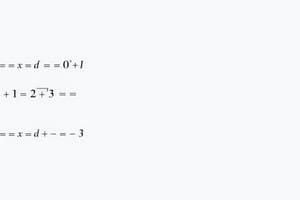Podcast
Questions and Answers
What does the slope of a linear equation represent?
What does the slope of a linear equation represent?
- The initial value of y when x is zero
- The point where the line crosses the y-axis
- The point where the line crosses the x-axis
- The rate of change of y with respect to x (correct)
What is the y-intercept of the equation y = -3x + 5?
What is the y-intercept of the equation y = -3x + 5?
- 0
- -5
- 5 (correct)
- -3
A line has a slope of 0. What does this indicate about the line?
A line has a slope of 0. What does this indicate about the line?
- The line is diagonal
- The line has a positive slope
- The line is vertical
- The line is horizontal (correct)
Which of the following equations represents a line with a negative slope?
Which of the following equations represents a line with a negative slope?
What is the slope of the line that passes through the points (2, 5) and (4, 1)?
What is the slope of the line that passes through the points (2, 5) and (4, 1)?
If the slope of a line is undefined, what can be said about the line?
If the slope of a line is undefined, what can be said about the line?
Which of the following equations is in slope-intercept form?
Which of the following equations is in slope-intercept form?
A car rental company charges a flat fee of $20 and an additional $0.25 per mile driven. Which equation represents the total cost (y) based on the number of miles driven (x)?
A car rental company charges a flat fee of $20 and an additional $0.25 per mile driven. Which equation represents the total cost (y) based on the number of miles driven (x)?
Flashcards
Slope-Intercept Form
Slope-Intercept Form
A linear equation format: y = mx + b, where m is slope and b is y-intercept.
Slope (m)
Slope (m)
Measures the steepness of a line; rate of change of y with respect to x.
Y-Intercept (b)
Y-Intercept (b)
The point where the line crosses the y-axis; value of y when x is zero.
Finding Slope and Y-Intercept
Finding Slope and Y-Intercept
Signup and view all the flashcards
Graphing with Slope-Intercept Form
Graphing with Slope-Intercept Form
Signup and view all the flashcards
Positive Slope
Positive Slope
Signup and view all the flashcards
Negative Slope
Negative Slope
Signup and view all the flashcards
Converting to Slope-Intercept Form
Converting to Slope-Intercept Form
Signup and view all the flashcards
Study Notes
Slope-Intercept Form Definition
- The slope-intercept form of a linear equation represents a linear relationship between two variables, typically x and y.
- It's expressed as y = mx + b, where:
- 'y' and 'x' are the variables.
- 'm' represents the slope of the line.
- 'b' represents the y-intercept, the point where the line crosses the y-axis.
Slope
- The slope (m) of a line measures its steepness.
- It indicates the rate of change of 'y' with respect to 'x'.
- A positive slope indicates an upward trend from left to right.
- A negative slope indicates a downward trend from left to right.
- A slope of zero indicates a horizontal line.
- An undefined slope indicates a vertical line.
Y-intercept
- The y-intercept (b) is the point where the line intersects the y-axis.
- At this point, the value of 'x' is always zero.
- It represents the initial value of 'y' when 'x' is zero.
Finding the Slope and Y-intercept
- To find the slope and y-intercept of a linear equation in the form y = mx + b, simply identify the values of 'm' and 'b'.
- For example, in the equation y = 2x + 3, the slope is 2 and the y-intercept is 3.
Graphing Using Slope-Intercept Form
- The slope-intercept form is particularly useful for graphing a linear equation.
- Two points are needed to draw the line:
- First plot the y-intercept (b) on the y-axis.
- Then use the slope (m) to find a second point. The slope, represented as rise over run (change in y over change in x), shows how to move from the y-intercept to the next point.
- For example, if the slope is 2/3, you would move up 2 units on the y-axis and to the right 3 units on the x-axis to find the next point.
Applications
- The slope-intercept form is widely used in various applications including:
- Modeling real-world scenarios where a linear relationship exists, such as calculating total cost (y) based on per-unit cost (m) and an initial cost (b).
- Solving linear equations
- Analyzing and interpreting data presented as linear graphs
Converting other forms to Slope-Intercept Form
- Equations not in the form y = mx + b can be transformed:
- Isolate y on one side of the equation.
- Rearrange terms to obtain the form y = mx + b. Example: 2x + y = 5 becomes y = -2x + 5.
Studying That Suits You
Use AI to generate personalized quizzes and flashcards to suit your learning preferences.




